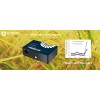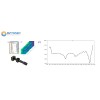Hyperspectral imaging system detects and characterizes the spectralum of microplastics
Hyperspectral images of the plastics and filter substrates were collected as data cubes in the NIR range (900–1700 nm) using a benchtop HSI system with geometry of reflection.
Microplastic pollution has become an urgent issue because it adversely affects ecosystems.However, efficient methods to detect and characterize microplastic particles are still in development. distinct spectral features at 1150–1250 nm, 1350–1450 nm and 1600–1700 nm, enabling their automatic recognition and identification with spectral separation algorithms. Using an improved hyperspectral imaging system, we demonstrated the detection of three types of microplastic particles, polyethylene, polypropylene and polystyrene, down to 100 μm in diameter
In the wavelength range of 900–1700 nm, the 11 authentic plastic polymer samples showed distinctive absorptive features in three specific wavelength bands: 1150–1250 nm, 1350–1450 nm, and 1600–1700 nm . Different plastic polymers showed apparently different spectral features. Specifically, PE, the most widely used plastic polymer with the greatest annual production, showed two major absorptive features in 1195–1225 nm and 1385–1420 nm, accompanied by two other deviations from the baseline at 1150 nm and 1550 nm. PP showed different reflectance patterns at 1185–1230 nm and 1390–1420 nm. For comparison, the spectra of PS and ABS had similar characteristic features at ∼1130–1160 nm, 1195–1215 nm, and 1400–1420 nm. The results of The fundamental spectral features of PE, PP, and PS observed presented further discernible features with finer wavelength resolution at 2.5 nm, compared to 12 nm and 10 nm .

-1000x400.jpg)




-100x100.jpg)
















Comments: 0
No comments